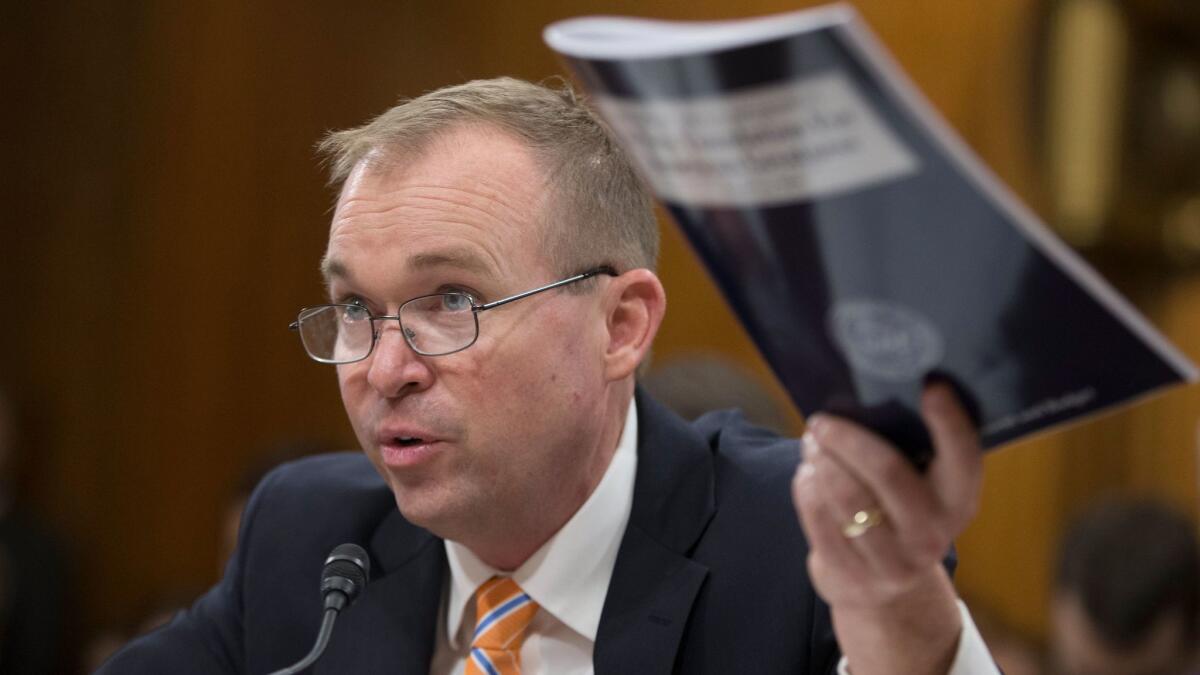Column: The Trump administration wants us to think 2 + 2 = 5

- Share via
The Trump administration got caught attempting to commit fake math last week. It didn’t succeed.
Here’s what happened: Every year, the president is required to send Congress a budget proposal, to lay out his wish list for taxes and spending. President Trump ordered up a plan that would lower taxes, increase military spending and balance the budget within 10 years, all without cutting Social Security or Medicare.
And that’s what his budget director, Mick Mulvaney, delivered. But to meet his boss’s unrealistic goals, Mulvaney produced a document that didn’t make much sense.
That’s not just my view; it’s the view of fiscal experts in both parties, including several senior Republicans in Congress who quickly declared the president’s budget dead on arrival.
What’s an embattled president to do when he can’t deliver? Attack the scorekeepers.
To reach Trump’s target, Mulvaney assumed that the economy will grow by an average of 3% a year for the next decade, a rate higher than any mainstream forecast. And he cut spending deeply on almost every non-defense function, from cancer research to Medicaid and other programs for the poor.
Even Republicans said the cuts were unrealistic.
“Meals on Wheels, even for some of us who are considered to be fiscal hawks, may be a bridge too far,” said Mark Meadows, chairman of the achingly conservative House Freedom Caucus.
Then it got worse. Budget experts noticed an oddity in Mulvaney’s arithmetic. The proposal estimated that his 3% growth in the economy would produce more than $2 trillion in increased tax revenue, helping to balance the budget. Most of that growth, in the administration’s view, would be produced by the big tax cuts it’s seeking.
But the budget didn’t mention the revenue that would be lost by the tax cuts — a number that could reach, oh, $2 trillion or so. Instead, it listed the tax cuts as “revenue neutral,” meaning they’d produce as much revenue as they lost — thanks, of course, to 3% growth.
In short, the White House counted the same $2 trillion twice — once to pay for the tax cuts and once to reduce the deficit.
That wasn’t the only oddity. The budget called for abolishing the estate tax, but nevertheless counted $330 billion of revenue from estate taxes. It called for funding Trump’s wall on the border with Mexico, but provided less than 10% of what the Department of Homeland Security says a wall would cost.
Of course, the Trump administration and its allies have had problems with arithmetic before.
They’ve raged against the nonpartisan Congressional Budget Office, which last week estimated that the House Republicans’ healthcare bill would result in 23 million more people without health insurance — and raise costs for millions more.
“The [CBO] is simply incompatible with the Trump era,” former House Speaker Newt Gingrich wrote with a double meaning that was presumably unintentional. “It is a left-wing, corrupt, bureaucratic defender of big government.” (The current CBO director was appointed by the Republican leaders of Congress.)
Trump officials have also contested the government’s estimates of unemployment — except when the number goes down, in which case they claim credit for the change.
They’ve claimed that Trump was the victim of widespread vote fraud on Election Day, despite the absence of evidence, arithmetical or otherwise. They’re even spending federal money to investigate the problem.
And the president still thinks he drew the largest crowds in history to his inauguration, even though photographs and calculations prove him wrong.
This refusal to accept that 2+ 2 = 4 isn’t ordinary political spin or the quirk of a former real estate developer who once promoted a 58-story building as offering 68 floors. The Trump administration’s war on math is just one front in a broader war on facts — including the new practice of dismissing any negative report as “fake news.”
And it’s strategic. It’s aimed at avoiding accountability.
Trump’s proudest claim, now that he’s president, is that he’s keeping the promises he made to voters in his campaign. Only he isn’t. His unrealistic budget plan won’t produce a balanced budget. The health care bill he backs won’t cover everyone, won’t reduce their costs, and won’t protect Medicaid. The tax cuts he said would benefit the middle class would flow mostly to the wealthy instead.
What’s an embattled president to do when he can’t deliver? Attack the scorekeepers — whether they are journalists, the CBO, or the budgeteers.
Most people, however, aren’t buying what Trump’s selling.
Being president, as Trump has complained, is harder than being a real estate promoter. There’s far more scrutiny.
In the case of the budget flimflam, for example, Trump may have outfoxed himself. One budget expert, former Senate Democratic aide Stan Collender, says the administration’s unrealistic numbers have probably killed Republicans’ chances for passing a tax bill this year — and maybe next year too.
If he’s right, that’s a big problem for Trump. Those tax cuts were the core of the president’s economic program, the key to producing anything like 3% growth. No tax cuts means no Trump bump. And voters would notice.
Trump is still waging his war on facts. But the facts are pushing back.
Twitter: @DoyleMcManus
Follow the Opinion section on Twitter @latimesopinion or Facebook
MORE FROM OPINION
To end the housing crisis, California leaders can’t be afraid to put all options on the table
Don’t worry, Hollywood. China’s not a threat
A court pays too much attention to Trump’s big mouth
Trump didn’t win any friends in Europe
More to Read
A cure for the common opinion
Get thought-provoking perspectives with our weekly newsletter.
You may occasionally receive promotional content from the Los Angeles Times.











